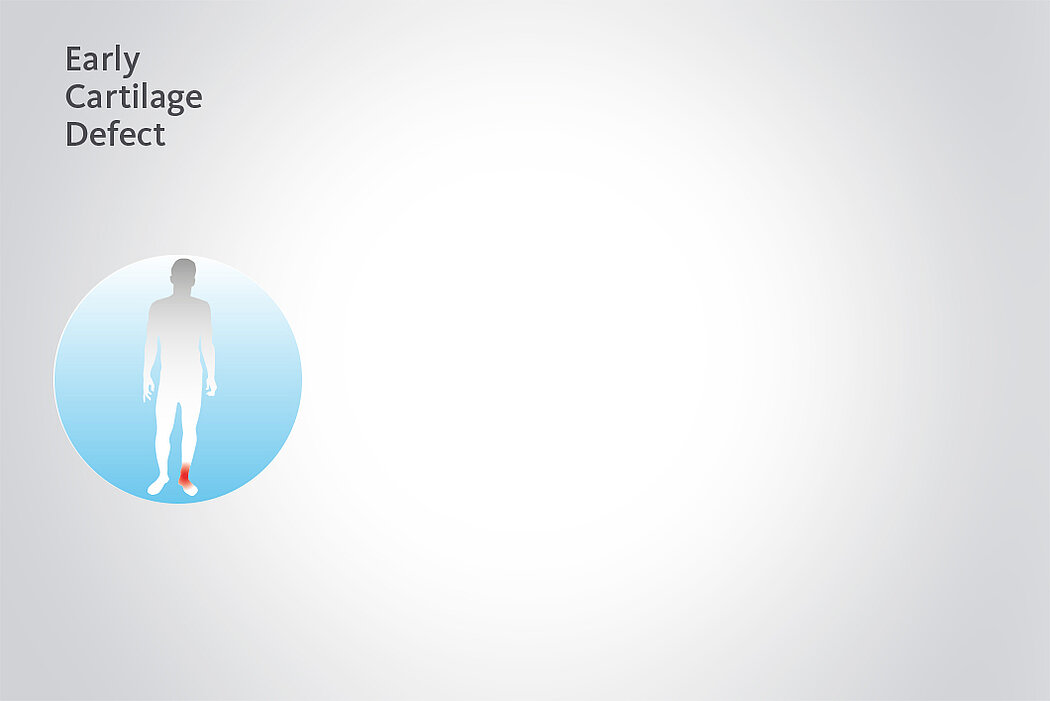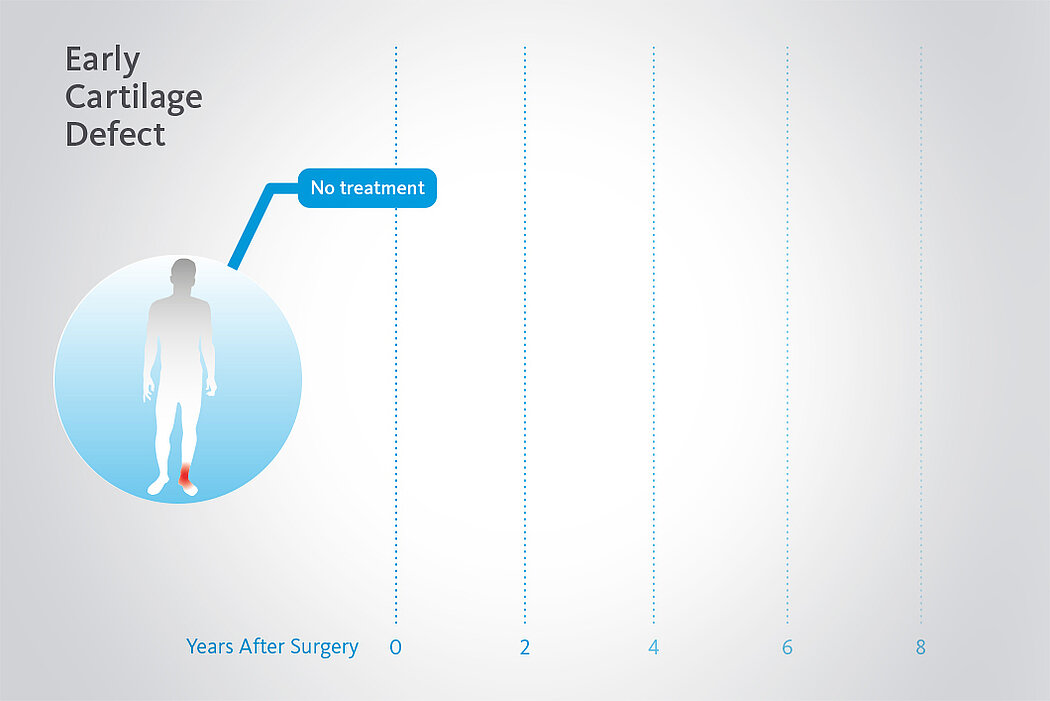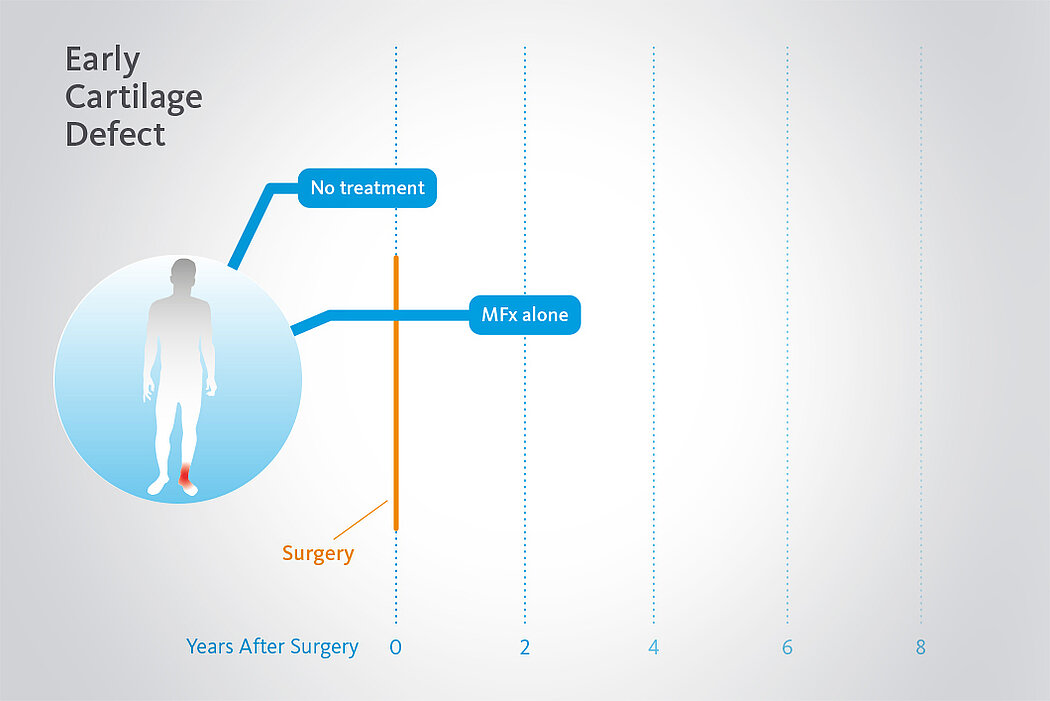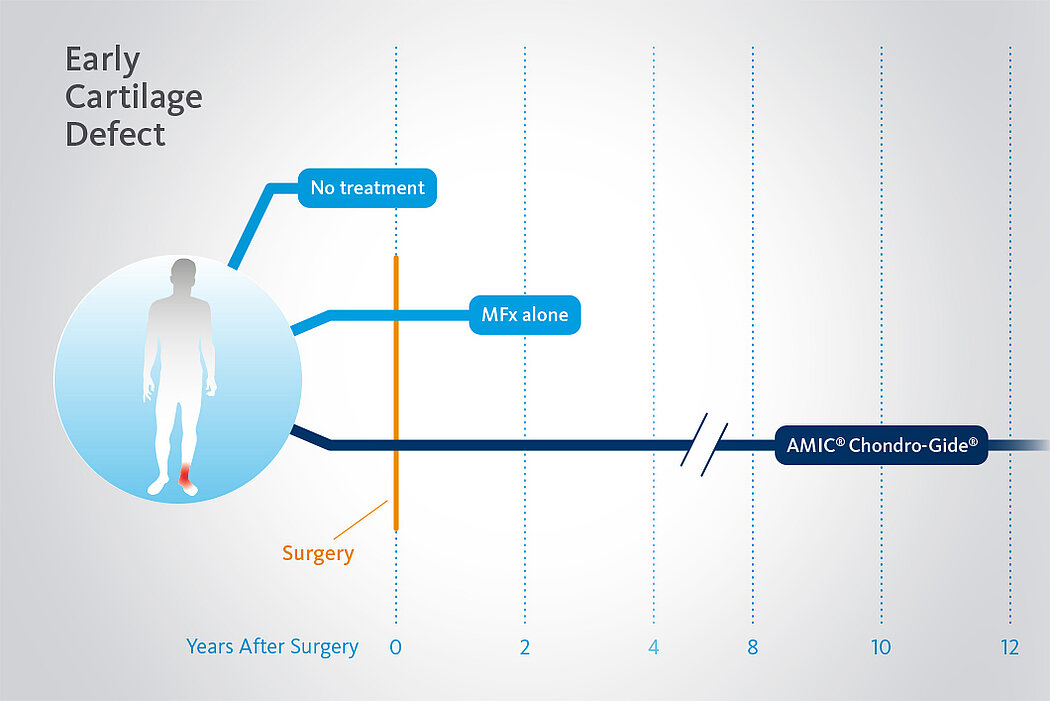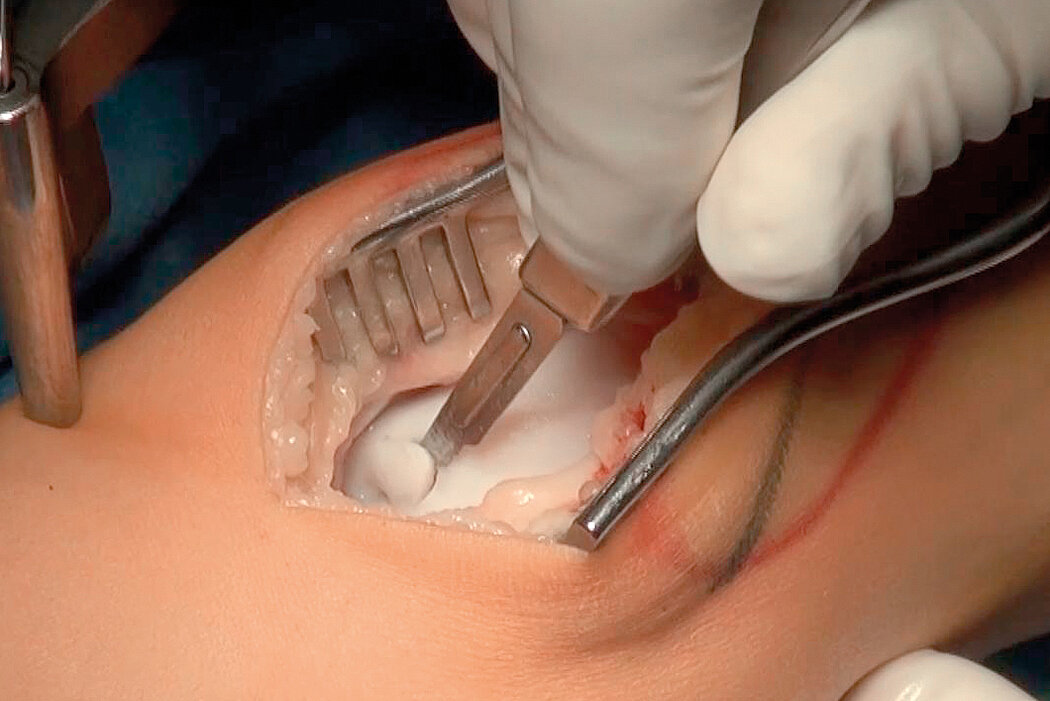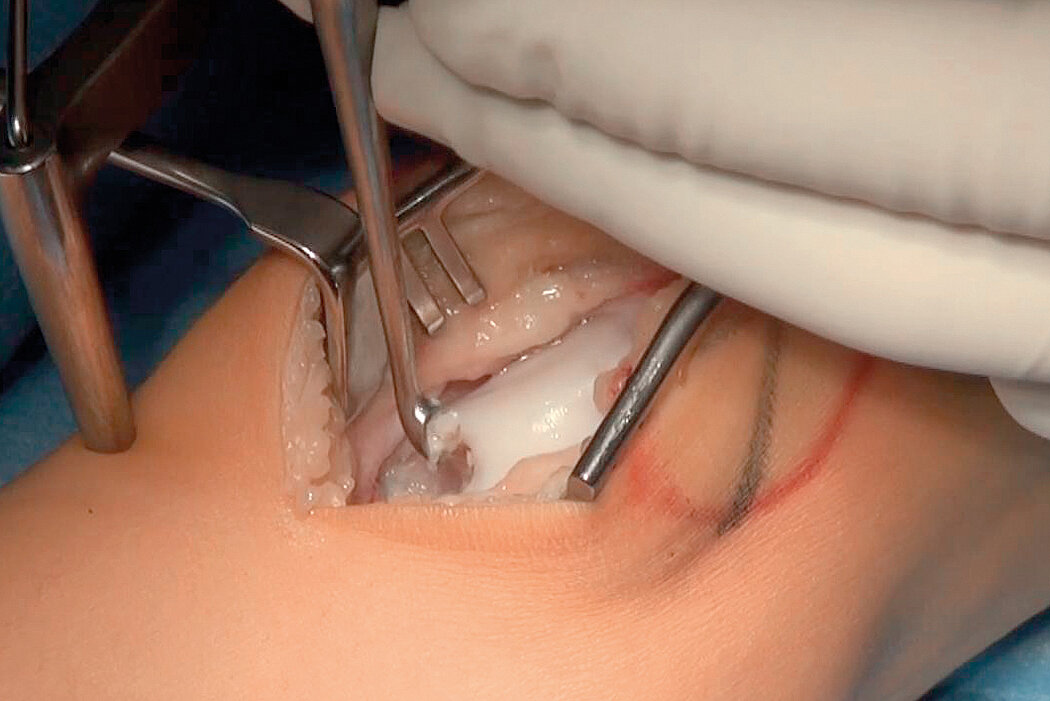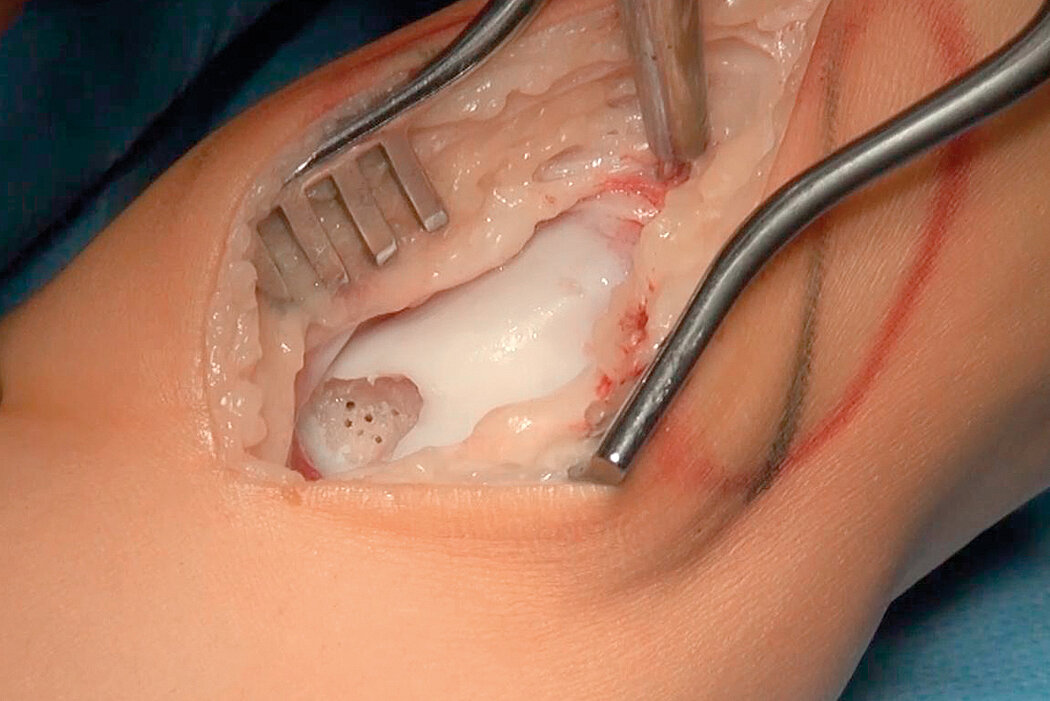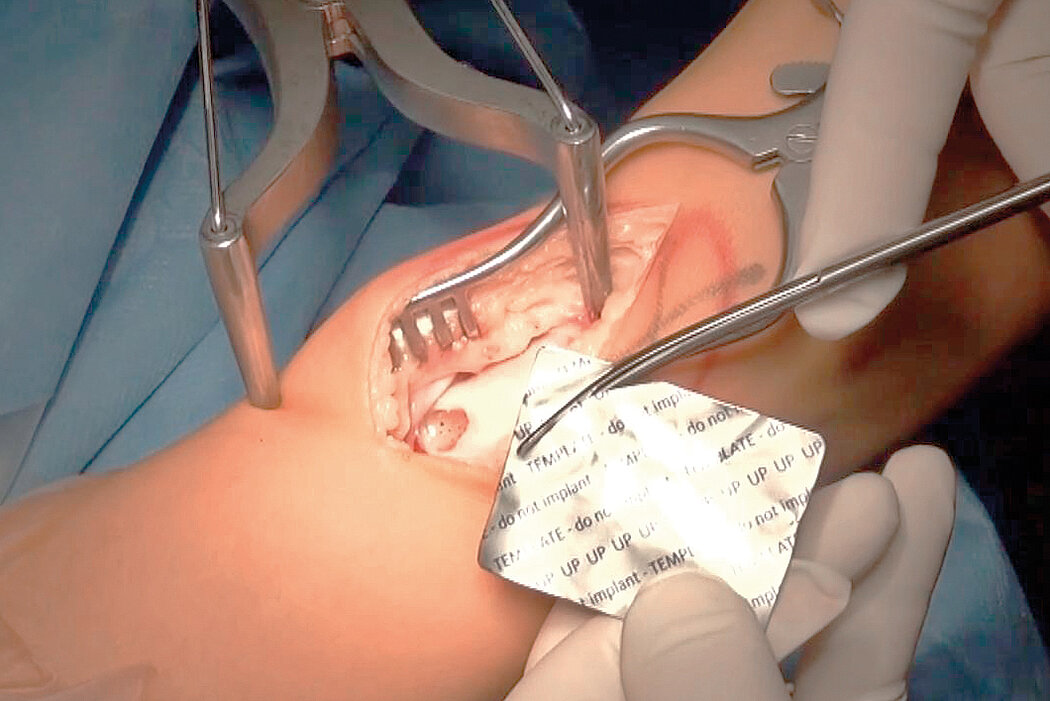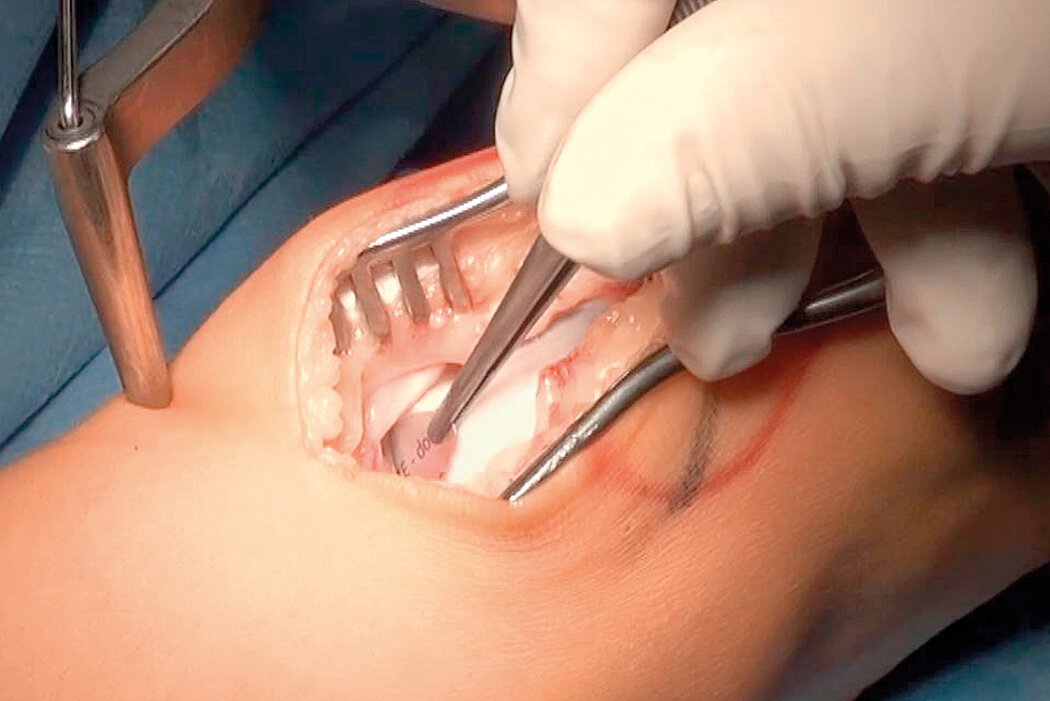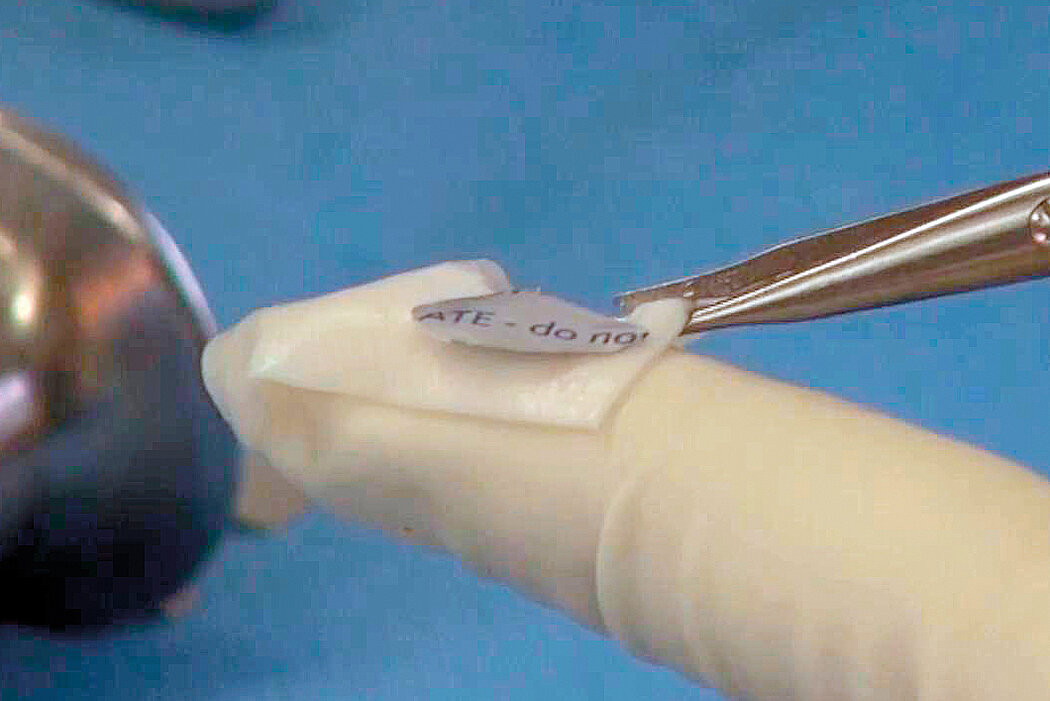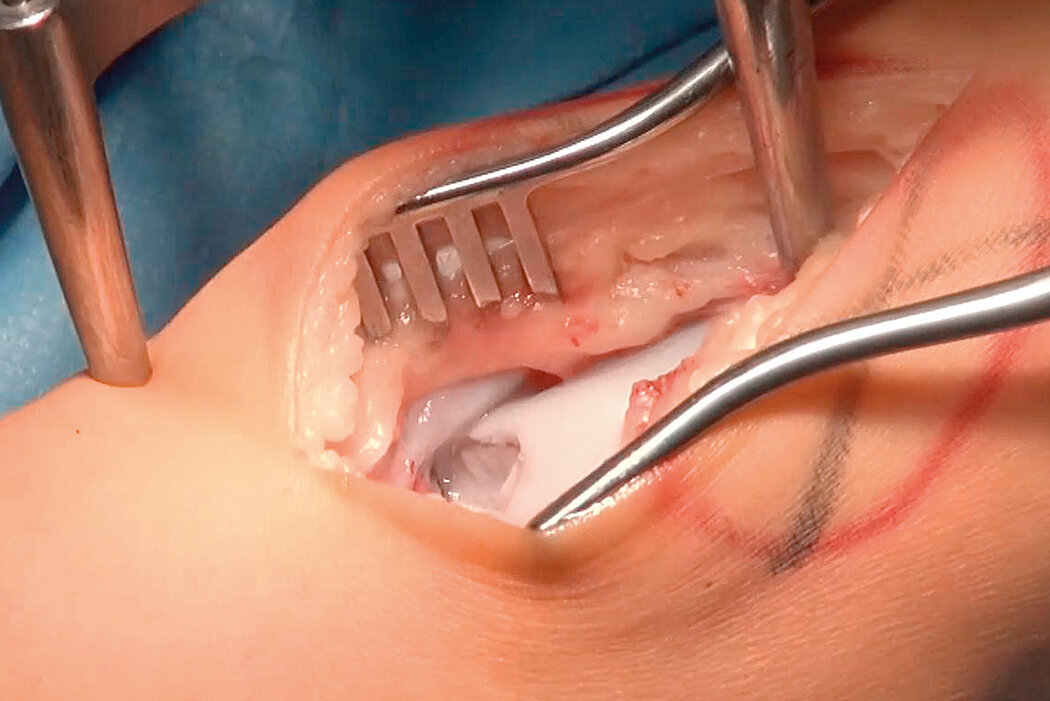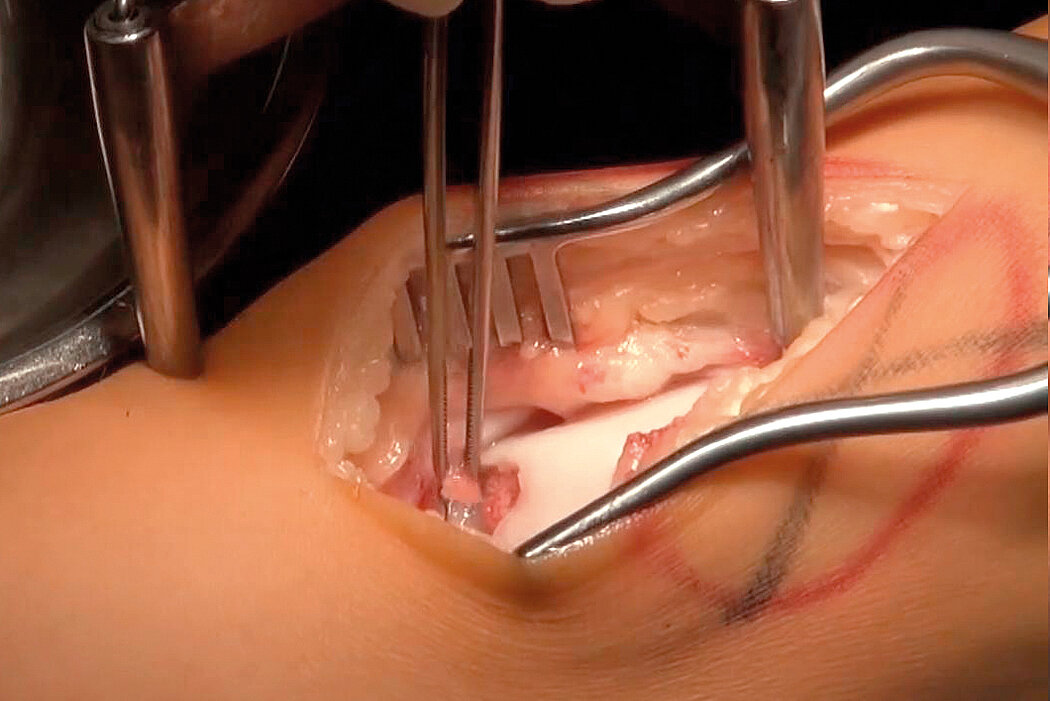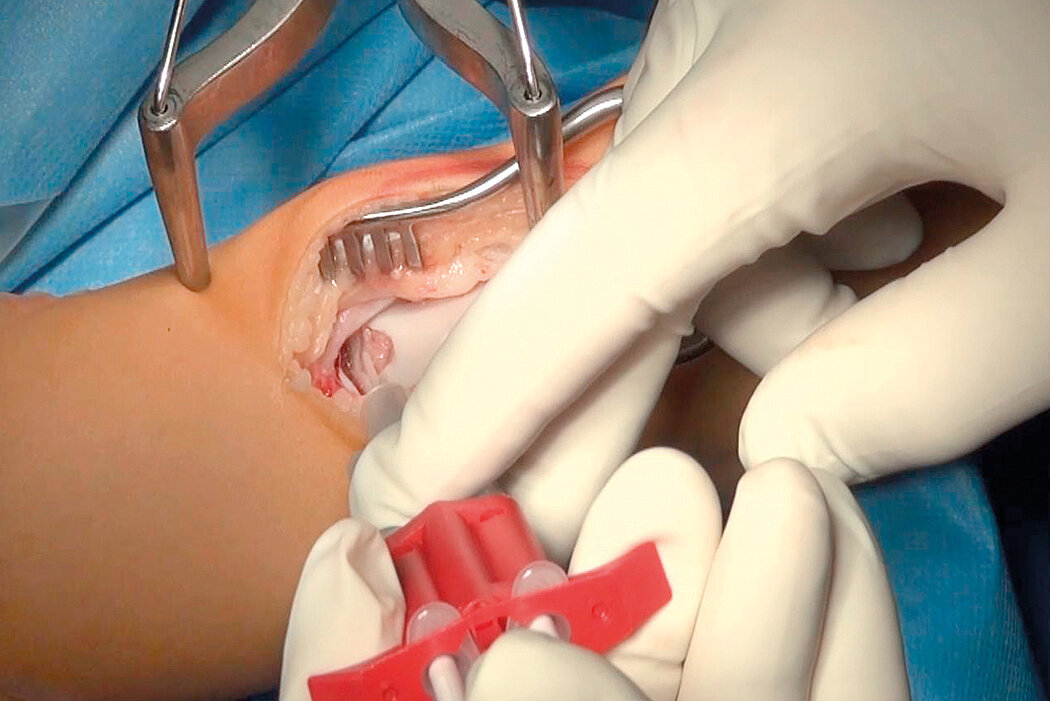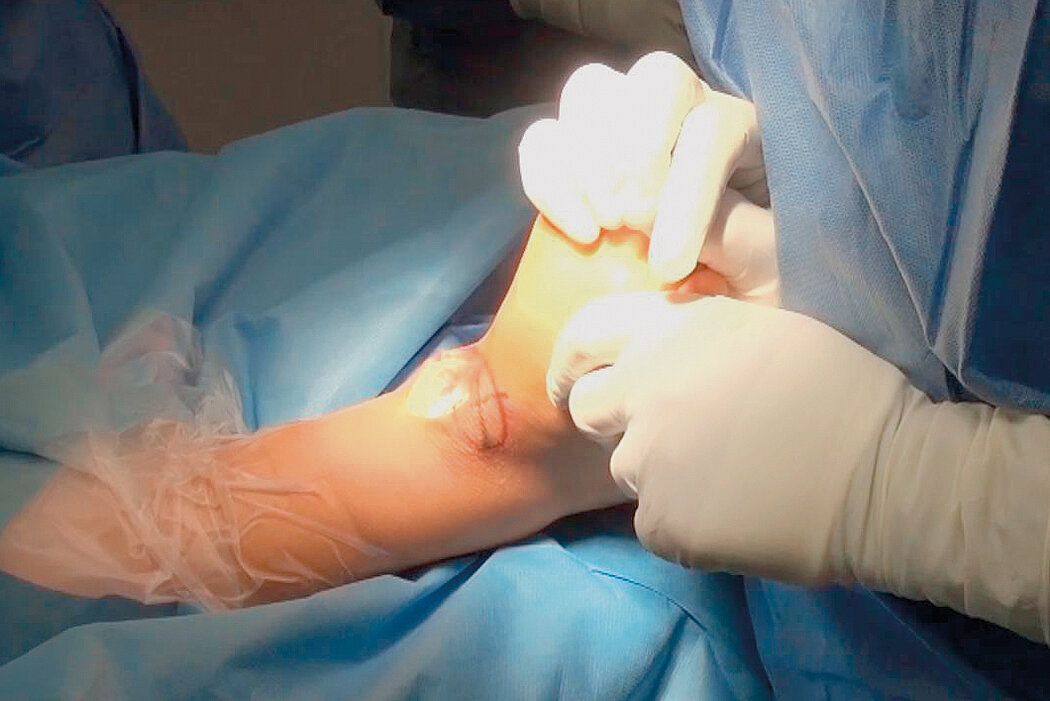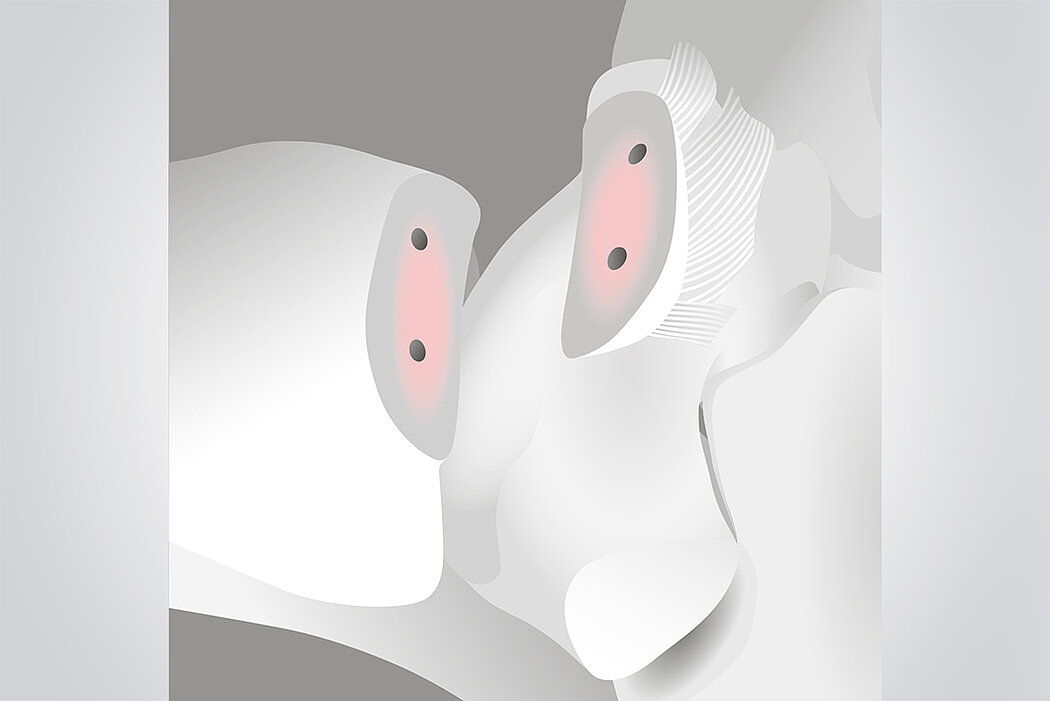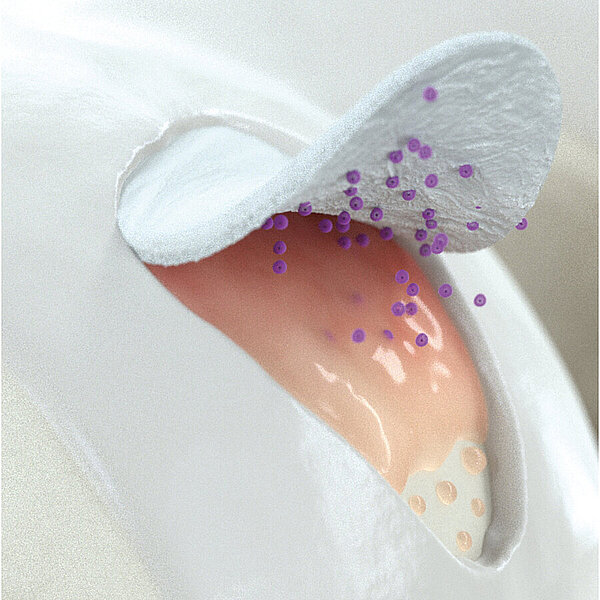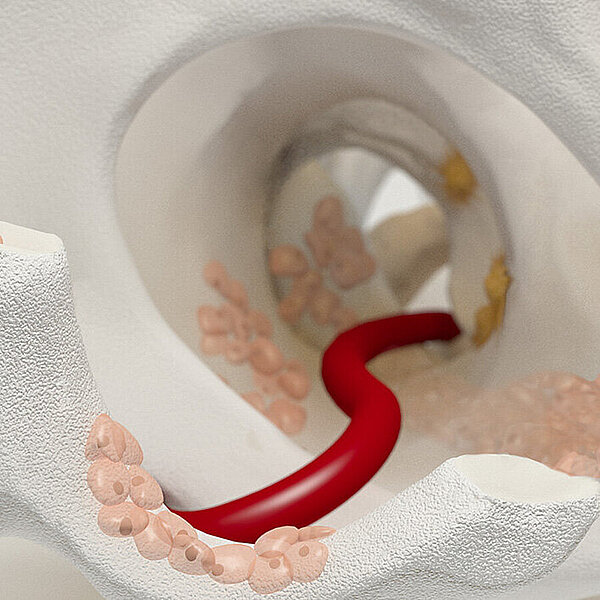AMIC® Chondro-Gide® no Talus
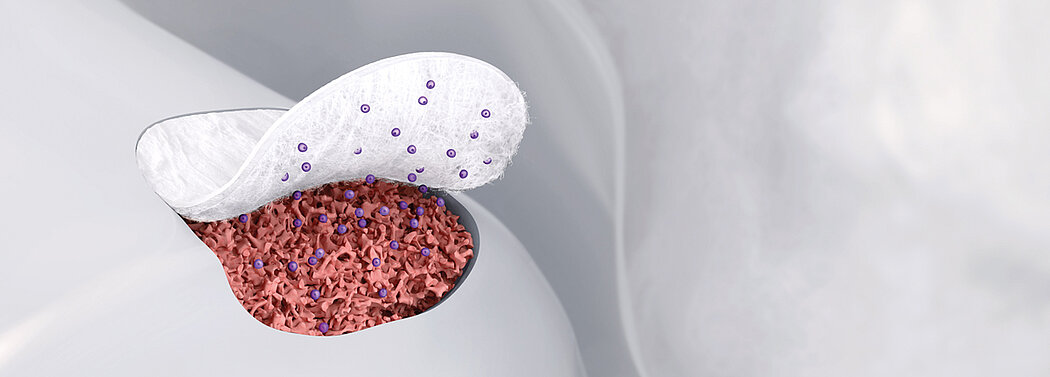
Lesões condrais e osteocondrais no tornozelo são comuns e reconhecidamente fontes de dor persistente na articulação. A maioria das lesões osteocondrais do tálus são ocasionadas devido a um trauma ou um microtrauma repetitivo .1 Cerca de 50% dos entorses de tornozelo e acima de 73% das fraturas de tornozelo resultam em lesão de cartilagem e podem causar sintomas.2
Estimulação Medular Recomendada Para Lesões Osteocondrais abaixo de 1 cm2
Ramponi et. al.3 recomendou que técnicas de estimulação medular devem ser indicadas para lesões osteocondrais menores do que 1 cm2. O limite de 1 cm2 também foi apoiado durante uma reunião de consenso do ISCRA (International Society on Cartilage Repair of the Ankle) em 2017. Para visualizar esta e outras declarações de consensos, visite o site da ON Foundation.
ISCRA definiu os guidelines de tamanho ideal para estimulação medular em diâmetro abaixo de 10 mm, uma área abaixo de 100 mm2, e uma profundidade abaixo de 5 mm.4 Enxertia óssea pode ser considerada para uma profundidade acima de 3 mm. Baseado na literatura atual, a recomendação consenso apoia o uso de um scaffold para complementar a enxertia óssea.5
AMIC® Chondro-Gide® para Regeneração de Cartilagem
AMIC® Chondro-Gide® é um procedimento minimamente invasivo de único tempo cirúrgico que utiliza estimulação medular em combinação com o Chondro-Gide para reparar defeitos de cartilagem de todos os tamanhos. Pode ser realizado por via artroscópica6 ou mini-artrotomia7.
Desenvolvida pela Geistlich Surgery em colaboração com cirurgiões pioneiros na Europa, AMIC® Chondro-Gide® é um tratamento eficaz e economicamente eficiente7 para reparar cartilagem danificada, aliviando ou prevenindo dor, e desacelerando a progressão do defeito.
References
- CHEW, K. T. L., 2008, Osteochondral lesions of the talus. Annals of the Academy of Medicine. 2008. Vol.37, no. 1, p. 63-8
- STEELE, J. R., et al., Osteochondral Lesions of the Talus. Foot & Ankle Orthopaedics. 2018. Vol. 3, no. 3, p. 247301141877955. DOI 10.1177/2473011418779559. SAGE Publications
- RAMPONI, L., et al., Lesion Size Is a Predictor of Clinical Outcomes After Bone Marrow Stimulation for Osteochondral Lesions of the Talus: A Systematic Review. The American Journal of Sports Medicine. 2016. Vol. 45, no. 7, p. 1698-1705. DOI10.1177/0363546516668292. SAGE Publications (Systematic Review)
- HANNON et al. Debridement, Curettage, Microfracture, and Fixation Techniques for Osteochondral Lesions of the Talus, 2018. Foot & Ankle Orthopaedics, Vol. 3, no. 3, p. 2473011418S0006. DOI 10.1177/2473011418s00066. SAGE Publications (Consensus Meeting Report)
- ROTHRAUFF, B.B., et al., Scaffold-Based Therapies: Proceedings of the International Consensus Meeting on Cartilage Repair of the Ankle. Foot & Ankle International. 2018. Vol. 39, no. 1_suppl, p. 41S-47S. DOI 10.1177/1071100718781864. SAGE Publications (Consensus Meeting)24. WALTHER, M., ALTENBERGER, S., KRIEGELSTEIN, S., VOLKERING, C. and R.SER, A., 2014, Reconstruction of focal cartilage defects in the talus with miniarthrotomy and collagen matrix. Operative Orthop.die und Traumatologie. 2014. Vol. 26, no. 6, p. 603-610. DOI 10.1007/s00064-012-0229-9. Springer Nature (Clinical Study)
- VALDERRABANO, V., et al., Reconstruction of Osteochondral Lesions of the Talus With Autologous Spongiosa Grafts and Autologous Matrix-Induced Chondrogenesis. The American Journal of Sports Medicine. 2013. Vol. 41, no. 3, p. 519-527.DOI 10.1177/0363546513476671. SAGE Publications (Clinical Study)
- WALTHER, M., et al., Reconstruction of focal cartilage defects in the talus with miniarthrotomy and collagen matrix. Operative Orthop.die und Traumatologie. 2014. Vol. 26, no. 6, p. 603-610. DOI 10.1007/s00064-012-0229-9. Springer Nature (Clinical Study)
- GOTTSCHALK, O., et al., Functional Medium-Term Results After Autologous Matrix-Induced Chondrogenesis for Osteochondral Lesions of the Talus: A 5-Year Prospective Cohort Study. The Journalof Foot and Ankle Surgery. 2017. Vol. 56, no. 5, p. 930-936. DOI 10.1053/j.jfas.2017.05.002. Elsevier BV (Clinical Study)
- YOUNG, KI WON, et al., Medial approaches to osteochondral lesion of the talus without medial malleolar osteotomy. Knee Surgery, Sports Traumatology, Arthroscopy. 2009. Vol. 18, no. 5, p. 634-637. DOI 10.1007/s00167-009-1019-2. Springer Nature
- GALLA, MELLANY, DUENSING, IAN, KAHN, TIMOTHY L. and BARG, ALEXEJ, 2018, Open reconstruction with autologous spongiosa grafts and matrix-induced chondrogenesis for osteochondral lesions of the talus can be performed without medial malleolar osteotomy. Knee Surgery, Sports Traumatology, Arthroscopy. 2018. DOI 10.1007/s00167-018-5063-7. Springer Nature (Clinical Study)
- Chondro-Gide® IFU 2019, Geistlich Pharma AG
- WALTHER, M., et al., Reconstruction of focal cartilage defects in the talus with miniarthrotomy and collagen matrix. Operative Orthopädie und Traumatologie. 2014. Vol. 26, no. 6, p. 603-610. DOI 10.1007/s00064-012-0229-9. Springer Nature (Clinical Study)
- GOTTSCHALK, O., et al., Functional Medium-Term Results After Autologous Matrix-Induced Chondrogenesis for Osteochondral Lesions of the Talus: A 5-Year Prospective Cohort Study. The Journal of Foot and Ankle Surgery. 2017. Vol. 56, no. 5, p. 930-936. DOI 10.1053/j.jfas.2017.05.002. Elsevier BV (Clinical Study)
- USUELLI, F., et al., All-arthroscopic AMIC® (AT-AMIC®) technique with autologous bone graft for talar osteochondral defects: clinical and radiological results. Knee Surgery, Sports Traumatology, Arthroscopy. 2016. Vol. 26, no. 3, p. 875-881. DOI 10.1007/s00167-016-4318-4. Springer Nature (Clinical Study)
References
- CHEW, K. T. L., 2008, Osteochondral lesions of the talus. Annals of the Academy of Medicine. 2008. Vol.37, no. 1, p. 63-8
- STEELE, J. R., et al., Osteochondral Lesions of the Talus. Foot & Ankle Orthopaedics. 2018. Vol. 3, no. 3, p. 247301141877955. DOI 10.1177/2473011418779559. SAGE Publications
- RAMPONI, L., et al., Lesion Size Is a Predictor of Clinical Outcomes After Bone Marrow Stimulation for Osteochondral Lesions of the Talus: A Systematic Review. The American Journal of Sports Medicine. 2016. Vol. 45, no. 7, p. 1698-1705. DOI10.1177/0363546516668292. SAGE Publications (Systematic Review)
- HANNON et al. Debridement, Curettage, Microfracture, and Fixation Techniques for Osteochondral Lesions of the Talus, 2018. Foot & Ankle Orthopaedics, Vol. 3, no. 3, p. 2473011418S0006. DOI 10.1177/2473011418s00066. SAGE Publications (Consensus Meeting Report)
- ROTHRAUFF, B.B., et al., Scaffold-Based Therapies: Proceedings of the International Consensus Meeting on Cartilage Repair of the Ankle. Foot & Ankle International. 2018. Vol. 39, no. 1_suppl, p. 41S-47S. DOI 10.1177/1071100718781864. SAGE Publications (Consensus Meeting)24. WALTHER, M., ALTENBERGER, S., KRIEGELSTEIN, S., VOLKERING, C. and R.SER, A., 2014, Reconstruction of focal cartilage defects in the talus with miniarthrotomy and collagen matrix. Operative Orthop.die und Traumatologie. 2014. Vol. 26, no. 6, p. 603-610. DOI 10.1007/s00064-012-0229-9. Springer Nature (Clinical Study)
- VALDERRABANO, V., et al., Reconstruction of Osteochondral Lesions of the Talus With Autologous Spongiosa Grafts and Autologous Matrix-Induced Chondrogenesis. The American Journal of Sports Medicine. 2013. Vol. 41, no. 3, p. 519-527.DOI 10.1177/0363546513476671. SAGE Publications (Clinical Study)
- WALTHER, M., et al., Reconstruction of focal cartilage defects in the talus with miniarthrotomy and collagen matrix. Operative Orthop.die und Traumatologie. 2014. Vol. 26, no. 6, p. 603-610. DOI 10.1007/s00064-012-0229-9. Springer Nature (Clinical Study)
- GOTTSCHALK, O., et al., Functional Medium-Term Results After Autologous Matrix-Induced Chondrogenesis for Osteochondral Lesions of the Talus: A 5-Year Prospective Cohort Study. The Journalof Foot and Ankle Surgery. 2017. Vol. 56, no. 5, p. 930-936. DOI 10.1053/j.jfas.2017.05.002. Elsevier BV (Clinical Study)
- YOUNG, KI WON, et al., Medial approaches to osteochondral lesion of the talus without medial malleolar osteotomy. Knee Surgery, Sports Traumatology, Arthroscopy. 2009. Vol. 18, no. 5, p. 634-637. DOI 10.1007/s00167-009-1019-2. Springer Nature
- GALLA, MELLANY, DUENSING, IAN, KAHN, TIMOTHY L. and BARG, ALEXEJ, 2018, Open reconstruction with autologous spongiosa grafts and matrix-induced chondrogenesis for osteochondral lesions of the talus can be performed without medial malleolar osteotomy. Knee Surgery, Sports Traumatology, Arthroscopy. 2018. DOI 10.1007/s00167-018-5063-7. Springer Nature (Clinical Study)
- Chondro-Gide® IFU 2019, Geistlich Pharma AG
- WALTHER, M., et al., Reconstruction of focal cartilage defects in the talus with miniarthrotomy and collagen matrix. Operative Orthopädie und Traumatologie. 2014. Vol. 26, no. 6, p. 603-610. DOI 10.1007/s00064-012-0229-9. Springer Nature (Clinical Study)
- GOTTSCHALK, O., et al., Functional Medium-Term Results After Autologous Matrix-Induced Chondrogenesis for Osteochondral Lesions of the Talus: A 5-Year Prospective Cohort Study. The Journal of Foot and Ankle Surgery. 2017. Vol. 56, no. 5, p. 930-936. DOI 10.1053/j.jfas.2017.05.002. Elsevier BV (Clinical Study)
- USUELLI, F., et al., All-arthroscopic AMIC® (AT-AMIC®) technique with autologous bone graft for talar osteochondral defects: clinical and radiological results. Knee Surgery, Sports Traumatology, Arthroscopy. 2016. Vol. 26, no. 3, p. 875-881. DOI 10.1007/s00167-016-4318-4. Springer Nature (Clinical Study)
Técnica com Mini-Artrotomia descrita por Dr. Markus Walther
References
- CHEW, K. T. L., 2008, Osteochondral lesions of the talus. Annals of the Academy of Medicine. 2008. Vol.37, no. 1, p. 63-8
- STEELE, J. R., et al., Osteochondral Lesions of the Talus. Foot & Ankle Orthopaedics. 2018. Vol. 3, no. 3, p. 247301141877955. DOI 10.1177/2473011418779559. SAGE Publications
- RAMPONI, L., et al., Lesion Size Is a Predictor of Clinical Outcomes After Bone Marrow Stimulation for Osteochondral Lesions of the Talus: A Systematic Review. The American Journal of Sports Medicine. 2016. Vol. 45, no. 7, p. 1698-1705. DOI10.1177/0363546516668292. SAGE Publications (Systematic Review)
- HANNON et al. Debridement, Curettage, Microfracture, and Fixation Techniques for Osteochondral Lesions of the Talus, 2018. Foot & Ankle Orthopaedics, Vol. 3, no. 3, p. 2473011418S0006. DOI 10.1177/2473011418s00066. SAGE Publications (Consensus Meeting Report)
- ROTHRAUFF, B.B., et al., Scaffold-Based Therapies: Proceedings of the International Consensus Meeting on Cartilage Repair of the Ankle. Foot & Ankle International. 2018. Vol. 39, no. 1_suppl, p. 41S-47S. DOI 10.1177/1071100718781864. SAGE Publications (Consensus Meeting)24. WALTHER, M., ALTENBERGER, S., KRIEGELSTEIN, S., VOLKERING, C. and R.SER, A., 2014, Reconstruction of focal cartilage defects in the talus with miniarthrotomy and collagen matrix. Operative Orthop.die und Traumatologie. 2014. Vol. 26, no. 6, p. 603-610. DOI 10.1007/s00064-012-0229-9. Springer Nature (Clinical Study)
- VALDERRABANO, V., et al., Reconstruction of Osteochondral Lesions of the Talus With Autologous Spongiosa Grafts and Autologous Matrix-Induced Chondrogenesis. The American Journal of Sports Medicine. 2013. Vol. 41, no. 3, p. 519-527.DOI 10.1177/0363546513476671. SAGE Publications (Clinical Study)
- WALTHER, M., et al., Reconstruction of focal cartilage defects in the talus with miniarthrotomy and collagen matrix. Operative Orthop.die und Traumatologie. 2014. Vol. 26, no. 6, p. 603-610. DOI 10.1007/s00064-012-0229-9. Springer Nature (Clinical Study)
- GOTTSCHALK, O., et al., Functional Medium-Term Results After Autologous Matrix-Induced Chondrogenesis for Osteochondral Lesions of the Talus: A 5-Year Prospective Cohort Study. The Journalof Foot and Ankle Surgery. 2017. Vol. 56, no. 5, p. 930-936. DOI 10.1053/j.jfas.2017.05.002. Elsevier BV (Clinical Study)
- YOUNG, KI WON, et al., Medial approaches to osteochondral lesion of the talus without medial malleolar osteotomy. Knee Surgery, Sports Traumatology, Arthroscopy. 2009. Vol. 18, no. 5, p. 634-637. DOI 10.1007/s00167-009-1019-2. Springer Nature
- GALLA, MELLANY, DUENSING, IAN, KAHN, TIMOTHY L. and BARG, ALEXEJ, 2018, Open reconstruction with autologous spongiosa grafts and matrix-induced chondrogenesis for osteochondral lesions of the talus can be performed without medial malleolar osteotomy. Knee Surgery, Sports Traumatology, Arthroscopy. 2018. DOI 10.1007/s00167-018-5063-7. Springer Nature (Clinical Study)
- Chondro-Gide® IFU 2019, Geistlich Pharma AG
- WALTHER, M., et al., Reconstruction of focal cartilage defects in the talus with miniarthrotomy and collagen matrix. Operative Orthopädie und Traumatologie. 2014. Vol. 26, no. 6, p. 603-610. DOI 10.1007/s00064-012-0229-9. Springer Nature (Clinical Study)
- GOTTSCHALK, O., et al., Functional Medium-Term Results After Autologous Matrix-Induced Chondrogenesis for Osteochondral Lesions of the Talus: A 5-Year Prospective Cohort Study. The Journal of Foot and Ankle Surgery. 2017. Vol. 56, no. 5, p. 930-936. DOI 10.1053/j.jfas.2017.05.002. Elsevier BV (Clinical Study)
- USUELLI, F., et al., All-arthroscopic AMIC® (AT-AMIC®) technique with autologous bone graft for talar osteochondral defects: clinical and radiological results. Knee Surgery, Sports Traumatology, Arthroscopy. 2016. Vol. 26, no. 3, p. 875-881. DOI 10.1007/s00167-016-4318-4. Springer Nature (Clinical Study)
Evidência clínica - AMIC® Chondro-Gide® no Talus
Como o Chondro-Gide® Funciona
Chondro-Gide® fornece uma cobertura protetora e mantém no lugar as células liberadas pela estimulação medular do osso subcondral ou introduzidas dentro do defeito. É um complemento para tratamentos regenerativos para lesões condrais e osteocondrais. Enquanto mantém as células dentro do defeito nos estágios iniciais do processo de cicatrização, o Chondro-Gide® é reabsorvido entre 1- 4 meses11 e é substituído por um novo tecido de cartilagem.
Chondro-Gide® Eficaz sem Osteotomia
Diversos estudos demonstraram que Chondro-Gide® pode ser utilizado com eficácia sem a necessidade de osteotomia. Walther et al.12 descreveu a reconstrução de defeitos de cartilagem focais no tálus com mini-artrotomia e Chondro-Gide para defeitos focais de cartilagem, pela classificação ICRS grau III e IV em uma área acima de 1.5 cm2. Os pesquisadores revisaram resultados pós-operatórios de 14 pacientes por um período de follow-up acima de 30 meses. Todos pacientes demonstraram melhora nos scores AOFAS, de 50 a 89 pontos, com igual mobilidade em ambos os lados da articulação superior do tornozelo. Não foram observadas complicações intra-operatórias. Eles concluiram que AMIC® Chondro-Gide® é um procedimento simples. A membrana pode ser implantada por mini-artrotomia, sem osteotomia do maléolo medial ou lateral em praticamente todos os casos. Eles também consideraram AMIC® Chondro-Gide® um procedimento economicamente eficiente de único tempo cirúrgico comparado a reconstrução de cartilagem com a utilização de condrócitos cultivados in-vitro.
Em uma análise de resultados de médio-prazo, Gottschalk et al.13 encontrou resultados promissores em ambos os estudos de 2 e 5 anos de follow-up após o procedimento. Os pesquisadores encontraram a melhoria mais significante nos resultados clínicos no primero ano de pós operatório. Entre o 1o - e 5o ano de follow-up, não foi observado melhoria estatisticamente significante. Pacientes retornaram ao esporte em 5 anos.
References
- CHEW, K. T. L., 2008, Osteochondral lesions of the talus. Annals of the Academy of Medicine. 2008. Vol.37, no. 1, p. 63-8
- STEELE, J. R., et al., Osteochondral Lesions of the Talus. Foot & Ankle Orthopaedics. 2018. Vol. 3, no. 3, p. 247301141877955. DOI 10.1177/2473011418779559. SAGE Publications
- RAMPONI, L., et al., Lesion Size Is a Predictor of Clinical Outcomes After Bone Marrow Stimulation for Osteochondral Lesions of the Talus: A Systematic Review. The American Journal of Sports Medicine. 2016. Vol. 45, no. 7, p. 1698-1705. DOI10.1177/0363546516668292. SAGE Publications (Systematic Review)
- HANNON et al. Debridement, Curettage, Microfracture, and Fixation Techniques for Osteochondral Lesions of the Talus, 2018. Foot & Ankle Orthopaedics, Vol. 3, no. 3, p. 2473011418S0006. DOI 10.1177/2473011418s00066. SAGE Publications (Consensus Meeting Report)
- ROTHRAUFF, B.B., et al., Scaffold-Based Therapies: Proceedings of the International Consensus Meeting on Cartilage Repair of the Ankle. Foot & Ankle International. 2018. Vol. 39, no. 1_suppl, p. 41S-47S. DOI 10.1177/1071100718781864. SAGE Publications (Consensus Meeting)24. WALTHER, M., ALTENBERGER, S., KRIEGELSTEIN, S., VOLKERING, C. and R.SER, A., 2014, Reconstruction of focal cartilage defects in the talus with miniarthrotomy and collagen matrix. Operative Orthop.die und Traumatologie. 2014. Vol. 26, no. 6, p. 603-610. DOI 10.1007/s00064-012-0229-9. Springer Nature (Clinical Study)
- VALDERRABANO, V., et al., Reconstruction of Osteochondral Lesions of the Talus With Autologous Spongiosa Grafts and Autologous Matrix-Induced Chondrogenesis. The American Journal of Sports Medicine. 2013. Vol. 41, no. 3, p. 519-527.DOI 10.1177/0363546513476671. SAGE Publications (Clinical Study)
- WALTHER, M., et al., Reconstruction of focal cartilage defects in the talus with miniarthrotomy and collagen matrix. Operative Orthop.die und Traumatologie. 2014. Vol. 26, no. 6, p. 603-610. DOI 10.1007/s00064-012-0229-9. Springer Nature (Clinical Study)
- GOTTSCHALK, O., et al., Functional Medium-Term Results After Autologous Matrix-Induced Chondrogenesis for Osteochondral Lesions of the Talus: A 5-Year Prospective Cohort Study. The Journalof Foot and Ankle Surgery. 2017. Vol. 56, no. 5, p. 930-936. DOI 10.1053/j.jfas.2017.05.002. Elsevier BV (Clinical Study)
- YOUNG, KI WON, et al., Medial approaches to osteochondral lesion of the talus without medial malleolar osteotomy. Knee Surgery, Sports Traumatology, Arthroscopy. 2009. Vol. 18, no. 5, p. 634-637. DOI 10.1007/s00167-009-1019-2. Springer Nature
- GALLA, MELLANY, DUENSING, IAN, KAHN, TIMOTHY L. and BARG, ALEXEJ, 2018, Open reconstruction with autologous spongiosa grafts and matrix-induced chondrogenesis for osteochondral lesions of the talus can be performed without medial malleolar osteotomy. Knee Surgery, Sports Traumatology, Arthroscopy. 2018. DOI 10.1007/s00167-018-5063-7. Springer Nature (Clinical Study)
- Chondro-Gide® IFU 2019, Geistlich Pharma AG
- WALTHER, M., et al., Reconstruction of focal cartilage defects in the talus with miniarthrotomy and collagen matrix. Operative Orthopädie und Traumatologie. 2014. Vol. 26, no. 6, p. 603-610. DOI 10.1007/s00064-012-0229-9. Springer Nature (Clinical Study)
- GOTTSCHALK, O., et al., Functional Medium-Term Results After Autologous Matrix-Induced Chondrogenesis for Osteochondral Lesions of the Talus: A 5-Year Prospective Cohort Study. The Journal of Foot and Ankle Surgery. 2017. Vol. 56, no. 5, p. 930-936. DOI 10.1053/j.jfas.2017.05.002. Elsevier BV (Clinical Study)
- USUELLI, F., et al., All-arthroscopic AMIC® (AT-AMIC®) technique with autologous bone graft for talar osteochondral defects: clinical and radiological results. Knee Surgery, Sports Traumatology, Arthroscopy. 2016. Vol. 26, no. 3, p. 875-881. DOI 10.1007/s00167-016-4318-4. Springer Nature (Clinical Study)

References
- CHEW, K. T. L., 2008, Osteochondral lesions of the talus. Annals of the Academy of Medicine. 2008. Vol.37, no. 1, p. 63-8
- STEELE, J. R., et al., Osteochondral Lesions of the Talus. Foot & Ankle Orthopaedics. 2018. Vol. 3, no. 3, p. 247301141877955. DOI 10.1177/2473011418779559. SAGE Publications
- RAMPONI, L., et al., Lesion Size Is a Predictor of Clinical Outcomes After Bone Marrow Stimulation for Osteochondral Lesions of the Talus: A Systematic Review. The American Journal of Sports Medicine. 2016. Vol. 45, no. 7, p. 1698-1705. DOI10.1177/0363546516668292. SAGE Publications (Systematic Review)
- HANNON et al. Debridement, Curettage, Microfracture, and Fixation Techniques for Osteochondral Lesions of the Talus, 2018. Foot & Ankle Orthopaedics, Vol. 3, no. 3, p. 2473011418S0006. DOI 10.1177/2473011418s00066. SAGE Publications (Consensus Meeting Report)
- ROTHRAUFF, B.B., et al., Scaffold-Based Therapies: Proceedings of the International Consensus Meeting on Cartilage Repair of the Ankle. Foot & Ankle International. 2018. Vol. 39, no. 1_suppl, p. 41S-47S. DOI 10.1177/1071100718781864. SAGE Publications (Consensus Meeting)24. WALTHER, M., ALTENBERGER, S., KRIEGELSTEIN, S., VOLKERING, C. and R.SER, A., 2014, Reconstruction of focal cartilage defects in the talus with miniarthrotomy and collagen matrix. Operative Orthop.die und Traumatologie. 2014. Vol. 26, no. 6, p. 603-610. DOI 10.1007/s00064-012-0229-9. Springer Nature (Clinical Study)
- VALDERRABANO, V., et al., Reconstruction of Osteochondral Lesions of the Talus With Autologous Spongiosa Grafts and Autologous Matrix-Induced Chondrogenesis. The American Journal of Sports Medicine. 2013. Vol. 41, no. 3, p. 519-527.DOI 10.1177/0363546513476671. SAGE Publications (Clinical Study)
- WALTHER, M., et al., Reconstruction of focal cartilage defects in the talus with miniarthrotomy and collagen matrix. Operative Orthop.die und Traumatologie. 2014. Vol. 26, no. 6, p. 603-610. DOI 10.1007/s00064-012-0229-9. Springer Nature (Clinical Study)
- GOTTSCHALK, O., et al., Functional Medium-Term Results After Autologous Matrix-Induced Chondrogenesis for Osteochondral Lesions of the Talus: A 5-Year Prospective Cohort Study. The Journalof Foot and Ankle Surgery. 2017. Vol. 56, no. 5, p. 930-936. DOI 10.1053/j.jfas.2017.05.002. Elsevier BV (Clinical Study)
- YOUNG, KI WON, et al., Medial approaches to osteochondral lesion of the talus without medial malleolar osteotomy. Knee Surgery, Sports Traumatology, Arthroscopy. 2009. Vol. 18, no. 5, p. 634-637. DOI 10.1007/s00167-009-1019-2. Springer Nature
- GALLA, MELLANY, DUENSING, IAN, KAHN, TIMOTHY L. and BARG, ALEXEJ, 2018, Open reconstruction with autologous spongiosa grafts and matrix-induced chondrogenesis for osteochondral lesions of the talus can be performed without medial malleolar osteotomy. Knee Surgery, Sports Traumatology, Arthroscopy. 2018. DOI 10.1007/s00167-018-5063-7. Springer Nature (Clinical Study)
- Chondro-Gide® IFU 2019, Geistlich Pharma AG
- WALTHER, M., et al., Reconstruction of focal cartilage defects in the talus with miniarthrotomy and collagen matrix. Operative Orthopädie und Traumatologie. 2014. Vol. 26, no. 6, p. 603-610. DOI 10.1007/s00064-012-0229-9. Springer Nature (Clinical Study)
- GOTTSCHALK, O., et al., Functional Medium-Term Results After Autologous Matrix-Induced Chondrogenesis for Osteochondral Lesions of the Talus: A 5-Year Prospective Cohort Study. The Journal of Foot and Ankle Surgery. 2017. Vol. 56, no. 5, p. 930-936. DOI 10.1053/j.jfas.2017.05.002. Elsevier BV (Clinical Study)
- USUELLI, F., et al., All-arthroscopic AMIC® (AT-AMIC®) technique with autologous bone graft for talar osteochondral defects: clinical and radiological results. Knee Surgery, Sports Traumatology, Arthroscopy. 2016. Vol. 26, no. 3, p. 875-881. DOI 10.1007/s00167-016-4318-4. Springer Nature (Clinical Study)
Vários autores reportaram a vantagem de um procedimento artroscópico para o tratamento de lesões osteocondrais do tálus. O tratamento artroscópico pode reduzir trauma cirúrgico, e torna desnecessária uma osteotomia tibial ou fibular.4
Para mais informações sobre Chondro-Gide®, técnicas cirúrgicas, e insights clínicos, download the brochure.
References
- CHEW, K. T. L., 2008, Osteochondral lesions of the talus. Annals of the Academy of Medicine. 2008. Vol.37, no. 1, p. 63-8
- STEELE, J. R., et al., Osteochondral Lesions of the Talus. Foot & Ankle Orthopaedics. 2018. Vol. 3, no. 3, p. 247301141877955. DOI 10.1177/2473011418779559. SAGE Publications
- RAMPONI, L., et al., Lesion Size Is a Predictor of Clinical Outcomes After Bone Marrow Stimulation for Osteochondral Lesions of the Talus: A Systematic Review. The American Journal of Sports Medicine. 2016. Vol. 45, no. 7, p. 1698-1705. DOI10.1177/0363546516668292. SAGE Publications (Systematic Review)
- HANNON et al. Debridement, Curettage, Microfracture, and Fixation Techniques for Osteochondral Lesions of the Talus, 2018. Foot & Ankle Orthopaedics, Vol. 3, no. 3, p. 2473011418S0006. DOI 10.1177/2473011418s00066. SAGE Publications (Consensus Meeting Report)
- ROTHRAUFF, B.B., et al., Scaffold-Based Therapies: Proceedings of the International Consensus Meeting on Cartilage Repair of the Ankle. Foot & Ankle International. 2018. Vol. 39, no. 1_suppl, p. 41S-47S. DOI 10.1177/1071100718781864. SAGE Publications (Consensus Meeting)24. WALTHER, M., ALTENBERGER, S., KRIEGELSTEIN, S., VOLKERING, C. and R.SER, A., 2014, Reconstruction of focal cartilage defects in the talus with miniarthrotomy and collagen matrix. Operative Orthop.die und Traumatologie. 2014. Vol. 26, no. 6, p. 603-610. DOI 10.1007/s00064-012-0229-9. Springer Nature (Clinical Study)
- VALDERRABANO, V., et al., Reconstruction of Osteochondral Lesions of the Talus With Autologous Spongiosa Grafts and Autologous Matrix-Induced Chondrogenesis. The American Journal of Sports Medicine. 2013. Vol. 41, no. 3, p. 519-527.DOI 10.1177/0363546513476671. SAGE Publications (Clinical Study)
- WALTHER, M., et al., Reconstruction of focal cartilage defects in the talus with miniarthrotomy and collagen matrix. Operative Orthop.die und Traumatologie. 2014. Vol. 26, no. 6, p. 603-610. DOI 10.1007/s00064-012-0229-9. Springer Nature (Clinical Study)
- GOTTSCHALK, O., et al., Functional Medium-Term Results After Autologous Matrix-Induced Chondrogenesis for Osteochondral Lesions of the Talus: A 5-Year Prospective Cohort Study. The Journalof Foot and Ankle Surgery. 2017. Vol. 56, no. 5, p. 930-936. DOI 10.1053/j.jfas.2017.05.002. Elsevier BV (Clinical Study)
- YOUNG, KI WON, et al., Medial approaches to osteochondral lesion of the talus without medial malleolar osteotomy. Knee Surgery, Sports Traumatology, Arthroscopy. 2009. Vol. 18, no. 5, p. 634-637. DOI 10.1007/s00167-009-1019-2. Springer Nature
- GALLA, MELLANY, DUENSING, IAN, KAHN, TIMOTHY L. and BARG, ALEXEJ, 2018, Open reconstruction with autologous spongiosa grafts and matrix-induced chondrogenesis for osteochondral lesions of the talus can be performed without medial malleolar osteotomy. Knee Surgery, Sports Traumatology, Arthroscopy. 2018. DOI 10.1007/s00167-018-5063-7. Springer Nature (Clinical Study)
- Chondro-Gide® IFU 2019, Geistlich Pharma AG
- WALTHER, M., et al., Reconstruction of focal cartilage defects in the talus with miniarthrotomy and collagen matrix. Operative Orthopädie und Traumatologie. 2014. Vol. 26, no. 6, p. 603-610. DOI 10.1007/s00064-012-0229-9. Springer Nature (Clinical Study)
- GOTTSCHALK, O., et al., Functional Medium-Term Results After Autologous Matrix-Induced Chondrogenesis for Osteochondral Lesions of the Talus: A 5-Year Prospective Cohort Study. The Journal of Foot and Ankle Surgery. 2017. Vol. 56, no. 5, p. 930-936. DOI 10.1053/j.jfas.2017.05.002. Elsevier BV (Clinical Study)
- USUELLI, F., et al., All-arthroscopic AMIC® (AT-AMIC®) technique with autologous bone graft for talar osteochondral defects: clinical and radiological results. Knee Surgery, Sports Traumatology, Arthroscopy. 2016. Vol. 26, no. 3, p. 875-881. DOI 10.1007/s00167-016-4318-4. Springer Nature (Clinical Study)

